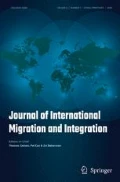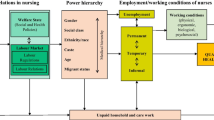Abstract
Qualitative interviews with Latvian and Swedish agency nurses in Norway reveal that the two groups have quite different experiences of integration in the Norwegian labor market. Aiming to add knowledge about differentiation within migrant labor markets, the objective of this article is to examine how language, nursing culture, and personal motivation affect the double control that agency nurses are subject to, their resultant skill-sets, inclusion in the workplace, and response to this. Norway is of interest as the Norwegian language can be difficult to learn outside Scandinavia. The Latvian agency nurses are harder hit by the double control of the temporary work agencies than the Swedish are. They obtain higher wages and better working conditions and are ready to speak up against unfair treatment. If they want to leave the agency, they easily find direct employment. Latvian nurses seem more ready to accept work below their qualifications and some show signs of “resigned acceptance.” They have more to lose than the Swedish nurses in terms of access to work, wages, and working conditions if they return to their homeland. Although Latvian and Swedish nurses largely feel well received in the workplace, the double control they are subject to calls for self-restraint and impedes a sense of inclusion. For the Latvian nurses, language problems and cultural differences exacerbate this. The study expands and nuances how double control affects agency workers, and applying a broad concept of resigned acceptance it nuances what language means for discrimination in the workplace.
Similar content being viewed by others
Notes
A few private actors operate in nursing homes and homecare in the municipal health sector, acting on behalf of the municipality.
These are unpublished figures obtained from Statistics Norway. The figures include directly employed nurses and nurses working for agencies based in Norway, and they refer to a representative week in November.
In 2015, average monthly wage for non-specialized nurses in Norway was NOK 41100 (EUR 4591); for specialized nurses, it was NOK 44500 (EUR 4970) (Statistics Norway 2017). In Latvia, average gross monthly wage for specialist nurses was 759.80 EUR in December 2016 and 729.30 EUR in December 2015 (Central Statistical Bureau of Latvia 2017).
Maiken Bjerga Kiil conducted the bulk of the interviews with the Swedish nurses, see also Kiil (2015).
This could be explained by technicalities of the shift-work system.
References
Allan, H. T., & Westwood, S. (2016). English language skills requirements for internationally educated nurses working in the care industry: barriers to UK registration or institutionalised discrimination? Editorial. International Journal of Nursing Studies, 54, 1–4.
Baltic Institute of Social Science (2016). Qualitative study on health system bottlenecks in Latvia. World Bank. http://www.vmnvd.gov.lv/uploads/files/5746bc728b03e.pdf. Accessed Sept 2017.
Batnitzky, A., & McDowell, L. (2011). Migration, nursing, institutional discrimination and emotional/affective labour: ethnicity and labour stratification in the UK National Health Service. Social & Cultural Geography, 12(2), 181–201.
Berge, Ø. M., Falkum, E., Trygstad, S. C., & Ødegård, A. M. (2011). Skaff oss dem vi trenger (Om arbeidskraftstrategier og forebygging av sosial dumping i helse og omsorg. Fafo-rapport 2011:20). Oslo: Fafo.
Blackledge, A. (2005). Discourse and power in a multilingual world. Amsterdam: John Benjamins.
Buchan, J., Jobanputra, R., Gough, P., Hutt R. (2005). Internationally recruited nurses in London. In: Profile and implications for policy. King’s fund working paper, September. London: King’s Fund.
Central Statistical Bureau of Latvia (2017). Average and real monthly wages and salaries. http://www.csb.gov.lv/en/statistikas-temas/metodologija/average-and-real-monthly-wages-and-salaries-36647.html. Accessed Oct 2017.
De Ruyter, A., Kirkpatrick, I., Hoque, K., Lonsdale, C., & Malan, J. (2008). Agency working and degradation of public service employment: the case of nurses and social workers. The International Journal of Human Resources and Management, 19(3), 432–445.
Fangen, K. (2010). Social exclusion and inclusion of young immigrants. Young, 18(2), 133–156.
Fangen, K., & Paasche, E. (2013). Young adults of ethnic minority background on the Norwegian labour market: the interactional co-construction of exclusion by employers and customers. Ethnicities, 13(5), 607–624.
Gautun, H., Øien, H., Bratt, C. (2016). Underbemanning er selvforsterkende. Konsekvenser av mangel på sykepleiere i hjemmesykepleien og sykehjem. NOVA-report 6/2016. http://www.hioa.no/Om-OsloMet/Senter-for-velferds-og-arbeidslivsforskning/NOVA/Publikasjonar/Rapporter/2016/Underbemanning-er-selvforsterkende. Accessed March 2019.
Gottfried, H. (1991). Mechanisms of control in the temporary help service industry. Sociological Forum, 6(4), 699–713.
Gottfried, H. (1992). In the margins: flexibility as a mode of regulation in the temporary help service industry. Work, Employment and Society, 6(3), 443–460.
Hull, M. (2016). Medical language proficiency: a discussion of interprofessional language competencies and potential for language risks. International Journal of Nursing Studies, 54, 158–172.
Jose, M. M. (2010). Lived experiences of internationally educated nurses in hospitals in the United States of America. International Nursing Review, 58(1), 123–129.
Kiil, M.B. (2015). Midlertidighet som protest: Svenske sykepleiere og det norske arbeidsmarkedet. Master thesis in Human Geography, University of Oslo. https://www.duo.uio.no/handle/10852/56/browse?value=Kiil%2C+Maiken+Bjerga&type=author (Accessed December 2018)
Kiil, M. B., & Knutsen, H. M. (2016). Agency by exit: Swedish nurses and the ‘Not below 24, 000’- movement. Geoforum, 70, 105–114.
Larsen, J. A. (2007). Embodiment of discrimination and overseas nurses’ career progression. Journal of Clinical Nursing, 16(12), 2187–2195.
Lember, M., & Nool, I. (2012). Changing brain drain to brain circulation: how to secure enough PHC resources in the BSR. Professional Development, EU: Baltic Sea Region Programme.
Lloyd, L., Banerjee, A., Harrington, C., Jacobsen, F., & Szebehely, M. (2014). It is a scandal! Comparing the causes and consequences of nursing home media scandals in five countries. International Journal of Sociology and Social Policy, 34(1/2), 2–18.
Magnusdottir, H. (2005). Overcoming strangeness and communication barriers: a phenomenological study of becoming a foreign nurse. International Nursing Review, 52(4), 263–269.
Marcus, K., Short, S., & Nardi, B. (2014). “Hardworkers”: Filipino nurses’ professional practice in Queensland. Asia and Pacific Journal of Health Management, 9(1), 28–34.
National Nursing Research Unit (2014). Nurse migration from the EU: what are the key challenges? Policy. https://www.kcl.ac.uk/nursing/research/nnru/policy/by-issue-number/policy%2D%2Dissue-42.pdf. Accessed March 2017.
NAV (2017). Bedriftsundersøkelsen våren 2017 (pdf) The labour and welfare directorate, Oslo (accessed June 2017).
Newton, S., Pillay, J., & Higginbottom, G. (2012). The migration and transitioning experiences of internationally educated nurses: a global perspective. Journal of Nursing Management, 20(4), 534–550.
NSF (2018) Utfordrende å rekruttere sykepleiere. Norwegian Nurses Association. https://www.nsf.no/vis-artikkel/3741618/17036/Utfordrende-aa-rekruttere-sykepleiere. Accessed Dec 2018.
O’Neill, F. (2011). From language classroom to clinical context: the role of language and culture in communication of nurses using English as a second language. A thematic analysis. International Journal of Nursing Studies, 48(9), 1120–1128.
Primeau, M.-D., Champagne, F., & Lavoie-Tremblay, M. (2014). Foreign-trained nurses’ experiences and socioprofessional integration. Best practices. An integrative literature review. The Health Care Manager, 33(3), 245–253.
Raghuram, P. (2007). Interrogating the language of integration: the case of internationally recruited nurses. Journal of Clinical Nursing, 16(12), 2246–2251.
Shohamy, E. (2009). Language tests for immigrants: Why language? Why tests? Why citizenship? In G. Hogan-Brun, C. Mar-Molinero, & P. Stevenson (Eds.), Discourses on language and integration (pp. 45–59). Amsterdam: John Benjamins.
Skjøstad, O., Hjemås, G, Beyrer, S. (2017). 1 av 5 nyutdanna sykepleiere jobber ikke helsetjensten. https://www.ssb.no/helse/artikler-og-publikasjoner/1-av-5-nyutdanna-sykepleiere-jobber-ikke-i-helsetjenesten. Accessed Nov 2017.
Smith, P., & Mackintosh, M. (2007). Profession, market and class: nurse migration and the remaking of division and disadvantage. Journal of Clinical Nursing, 16(12), 2213–2220.
Statistics Norway (2016). Helse-og sosialpersonell 2015, 4. kvartal. https://www.ssb.no/arbeid-og-lonn/statistikker/hesospers/aar/2016-06-27?fane=tabell&sort=nummer&tabell=270653. Accessed March 2017.
Statistics Norway Databank (2017). Wages nurse, wages specialist nurses. https://www.ssb.no/statistikkbanken/SelectVarVal/Define.asp?MainTable=NaerHelseYrk2&KortNavnWeb=lonnhelse&PLanguage=0&checked=true. Accessed March 2017.
Sykepleien (2015). Liten nytte av å melde avvik. https://sykepleien.no/2015/03/1-av-2-ser-ikke-nytten-av-melde. Accessed March 2017.
Tailby, S. (2005). Agency and bank nursing in the UK National Health Service. Work, Employment and Society, 19(2), 369–389.
Tuttas, C. A. (2015). Perceived racial and ethnic prejudice and discrimination experiences of minority migrant nurses: a literature review. Journal of Transcultural Nursing, 26(5), 514–520.
Widding Isaksen, L. (2012). Transnational spaces of care: migrant nurses in Norway. Social Politics, 19(1), 58–77.
Yin, R. K. (2014). Case study research: design and methods (5th ed.). Los Angeles: Sage.
Young, A., & Temple, B. (2014). Approaches to social research: the case of deaf studies. New York: Oxford University Press.
Zampoukos, K., Knutsen, H. M., Kiil, M. B., & Olofsdotter, G. (2018). Mobile with an agency: negotiating the spatiotemporalities of the temp migrant worker. Geoforum, 93, 40–47.
Funding
We are thankful to the Research Council of Norway for funding as part of the research project: The impact of temporary work agencies on the politics of work. Ref. 227021.
Author information
Authors and Affiliations
Corresponding author
Additional information
Publisher’s Note
Springer Nature remains neutral with regard to jurisdictional claims in published maps and institutional affiliations.
Rights and permissions
About this article
Cite this article
Knutsen, H.M., Fangen, K. & Žabko, O. Integration and Exclusion at Work: Latvian and Swedish Agency Nurses in Norway. Int. Migration & Integration 21, 413–429 (2020). https://doi.org/10.1007/s12134-019-00660-5
Published:
Issue Date:
DOI: https://doi.org/10.1007/s12134-019-00660-5




